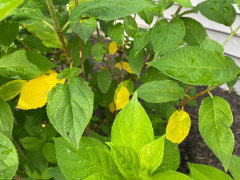The smart Trick of Hydrangea Leaves Turning Yellow That Nobody is Talking About
Wiki Article
A Biased View of Hydrangea Leaves Turning Yellow
Table of Contents5 Simple Techniques For Hydrangea Leaves Turning YellowThe smart Trick of Hydrangea Leaves Turning Yellow That Nobody is DiscussingThe Main Principles Of Hydrangea Leaves Turning Yellow What Does Hydrangea Leaves Turning Yellow Do?
Hydrangea plants are recognized for their stunning blooms, yet often their leaves can transform yellow. This is normally an indication that something is incorrect and the plant requires your assistance. There are several possible root causes of yellow leaves on Hydrangeas, and thankfully many of them are simple to deal with. Right here we'll cover one of the most typical root causes of Hydrangea leaves transforming yellow and how to repair them.Hydrangea leaves turning yellow can be a reason for worry. Hydrangea leaves commonly turn yellow when the plant is overwatered.
When the origins of a plant are immersed in water for extended periods, they start to stifle and rot. This process cuts off the origins' oxygen supply, causing the leaves to turn yellow and ultimately die. Overwatering can likewise cause other troubles such as leaf decrease, origin damages, and fungal growth.
If you believe your Hydrangea is overwatered, the ideal option is to allow the soil dry entirely before watering again. It's also an excellent idea to examine the water drainage of your pot or garden bed and ensure that water is not pooling around the plant's roots. Hydrangea plants require well-drained soil to flourish.
The Ultimate Guide To Hydrangea Leaves Turning Yellow
Hydrangea leaves can additionally turn yellow if the plant is not getting adequate water. This occurs when the plant does not get adequate water, and the soil begins to dry out.
This is known as "plant food burn," It takes place when the plant's origins are exposed to way too much plant food. The origins can not absorb all of the nutrients and become damaged. This damages causes the fallen leaves to transform yellow and eventually pass away. Other indicators of fertilizer melt consist of brown or yellow fallen leaves, wilting, and stunted development.
This will aid get rid of any type of excess fertilizer from the roots of the plant. It's likewise an excellent concept to reduce the amount of plant food you this post are using. Feeding as soon as a month throughout the growing period needs to be adequate. If you are utilizing chemical fertilizer, it's ideal to utilize one that is thinned down and used according to the producer's guidelines.
A Biased View of Hydrangea Leaves Turning Yellow

If your Hydrangea is plagued with parasites, dealing with the plant with neem or horticultural oil is the finest remedy. It's additionally excellent to get rid of any affected fallen leaves from the plant. You can do this by hand or with a pair of trimming shears. It's likewise a click to find out more good concept to check the plant frequently for parasites and remove them as soon as you see them.
To prevent spreading out the condition, guarantee to sanitize your scissors before reducing any type of leaves off. Hydrangea leaves can additionally transform yellow if the temperature worries the plant. This generally takes place when the plant is subjected to severe cool or warm. The leaves of the plant will certainly turn yellow and begin to hand over.
If the temperature level stresses your Hydrangea, you need to relocate the plant to a location where it will be shielded from the severe chilly or warm. You can likewise attempt to provide the plant with some partial color if exposed to guide sunshine. You can likewise attempt including mulch around the plant base to help regulate the temperature level.
An Unbiased View of Hydrangea Leaves Turning Yellow
When the plant's roots are submerged in water for too long, they begin to rot. One of the most usual origin rot symptoms is yellowing fallen leaves, as the fungi stops the origins from absorbing nutrients from the dirt.Check the origins of your Hydrangea if it has origin rot. If some healthy roots are left, you can try to save the plant by replanting it in a new pot with fresh soil.
Water the plant very carefully, making sure not to overwater it. If your Hydrangea is heavily influenced by root rot, beginning with a new plant is best. Natural reasons can also trigger yellow hydrangea leaves. One of the most typical reason is the plant's age. As Hydrangeas age, their fallen leaves will slowly transform yellow and brown prior home to diminishing the plant.
You can help the plant by guaranteeing it is obtaining adequate water and nutrients. One possibility is that the plant is not getting adequate water.
Report this wiki page